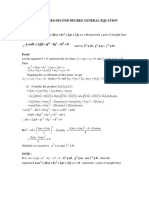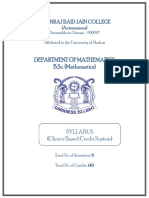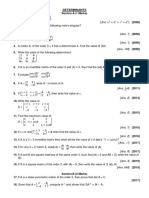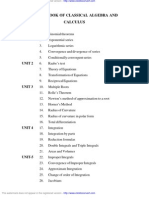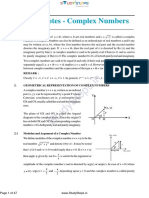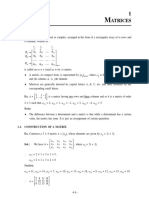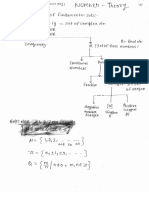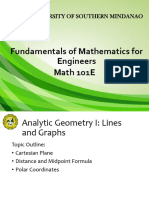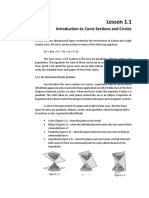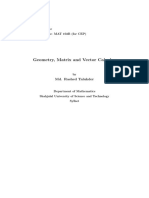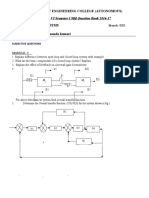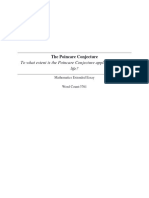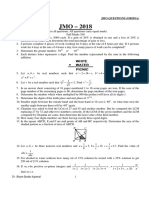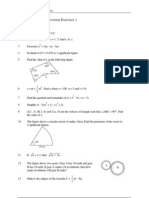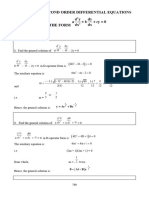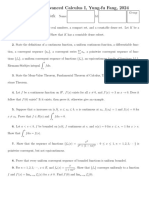1.
Introduction
For evaluating areas, volumes of revolution etc. we need to know the
general nature of the given curve. In this chapter we shall learn the methods of
tracing a curve in general and the properties of some standard curves commonly
met in engineering problems.
2. Procedure for tracing curves given in Cartesian equations
I. Symetry : Find out whether the curve is symmetrical about any line
with the help of the following rules :
( 1) The curve is symmetrical about the x axis if the equation of the curve
-
remains unchanged when y is replaced by- y i.e. if the equation contains only
even powers o f y.
(2) The curve is symmetrical about the y axis if the equation of the curve
-
remains unchanged when x is replaced by- x i.e. if the equation contains o nly
even powers of x.
(3) The curve is symmetrical in opposite quadrants if the equation of the
curve remains unchanged when both x andy are repl aced by- x and y.
-
(4) The curve is symmetrical about the line y = x if the equation of the
curve remains unchanged when x andy are interchanged.
II. Origin : Find out whether the origin lies on the curve. If it does, find
the equations of the tangents at the origin by equating to zero the lowest degre
terms.
III. Intersection with the cordinate axes : Find out the points of
intersection of the curve with the coordinate axes. Find also the equations of
the tangents at these points.
IV. Asymptotes : Find out the asymptotes if any.
V. Regions where no part of the curve lies : Find out the regions of the
plane where no part of the curve lies.
VI Find out dyldx : Find out dy/dx and the points where the tangents
are parallel to the coordinate axes.
�EngMrering Mathemat -
If
Tracing of Corwes
(7-2)
3. Common Curves
You have already studied quite in detail straight line, circle, parabola,
eJiipse and hyperbola, includi ng rectangular hyperbola. We shall briefly review
these curves.
Rectangular Coordinates
(a) Straight Line:
General equation of straight line is of the form ax +
by + c = 0.
To plot a straight line we put y = 0 and find x. Also we put x = 0 and find
y. We plot these two points
and join them to get the required line.
Some particular cases of straight Jines are shown below.
(i) Lines parallel to the coordinate axes.
y
y
x=h
y=k
X
Fig. (7.1)
Fig. (7.2)
(ii) Lines passing through origin
y
y=mx
m<O
y=mx
m>O
X
Fig. (7 .3)
Fig. (7.4)
(iii) Lines making given intercepts on coordinate axes.
y
Fig. (7 .5)
General equation of circle is :il
g,- h) and radius=
2 + J2- c
Fig. (7 6)
.
j + 2gx + 2/y + c = 0. Its centre is
�Engineering Mathematics
II
Tracing of Corves
(7- 3)
(i) Circle with centre at origin and radius
and
2 + j2- c.
(ii) Circle with centre at (- g,- f) and radius
are shown below.
y
Fig. (7.7)
Fig. (7.8)
(iii) Circle with centre on the x- axis and passing through origin.
Its equation is of the form x2 + i 2ax = 0.
y
-x
Fig. (7.9)
Fig. (7.10)
(iv) Circle with centre on they-axis and passing through origin.
Its equation is of the form x2 + i 2by = 0.
y
Fig. (7.11)
Fig. (7.12)
(v) Circle with centre on the axes but not passing through origin.
Its equation is of the form x2 +
y
Fig. (7.13)
l 2gx + c = 0, .-r? + i 2fy + c ='
y
,_Fig. (7.14)
�JTat:mg
v- ..,,
or .;orves
(vi) Circle touching both axes.
Its equation is of the form :Xl + l 2ax :;t 2ay+ a2 = 0.
y
Fig. (7.15)
l- 4x + 4y + 4 = 0
2
2
Sol. : We write the equation as (x - 2) + (y + 2) 2 = 2
Ex. 1 : Draw the circle :Xl
Its centre is
(2, -2) and radius = 2.
It is shown on the right.
Polar Coordinates
Fig. (7.16)
(a) Straight line
If We put X =rCOS 8, y = r Sin
8 in the equation Of the Straight line
ax+by+c=O
we get,
ar cos e + br sin e + c = 0
i.e.
cos
b sin e
(i) A line parallel to the initial line.
If a line is parallal to the initial line (or the
.:. = 0
x- ax is) at a ditance p from
it then, from the figure we see that its equation is
rsin e =p (It
p
0
is clear thatrsin e = p, if the line is
e =- p, if the line is
above the initial line andrsin
Fig. (7.17)
below the initial line.)
(ii) A line perpendicular to the initial line.
If a line is perpendienlar to the initial line (or the
x-
axis) at a ditance p from it then from the figure we
see thatrcos6=p
(It is clear thatrcos e = p, if the line is to the right
of the pole and rcos a =- p,
if the line is to the left of the
Fig. (7.18)
pole.)
. 0
Fig. (7.19)
(iii) A line through the pole (or the
origin)
If a line passes through the pole and makes an
�Engineering Mathematics
ang l e
II
Tracing of Corves
(7- 5)
a with the initalline then every point on the line has coordnates (r, a),
0= a
where r is positive or negative. Hence the equati on of a line is
In particular the equation of a line making
e = 1t/4.
an
angle of 45 is
(b) Circle
If we put X= r cos e. y = r s in e in the equation
of the circle with center at the origi n and radius a i.e.
in x 2 + y 2 = a 2 we get , r 2 = a 2
If We put X = r COS () y = r sin 0 in the equation
(a, 0) and radius a i.e. in
of the circle with center
Fig. (7.20)
(x- a) 2 + y 2 = a 2 i.e. in x 2 + y 2- 2ax = 0
we get r 2 -
2a r cos e = 0:. r = 2a cos e
This is the equation of the circle with cen ter (a, 0)
and radius a in polar coordniates.
If we put
= r cos e, y = r sin 0 in the
equation of the circle
with center (0, a) and
Fig. (7.21)
x
2 +
radius a i.e. in
(y- a) 2 =a 2 i.e.
we get, r 2 -
2ar sin e
x
=
2 + y 2-
i.e. r =
2ay = 0
2a sin e
This is the equation of the circle with center (0, a)
and radius a in polar
coordniates
Fig. (7.22)
If We put X= r COS 0, y = r sin 0 in the equation
of the cricle with center (a, a) and touching both
the coordniate axes in the first quadrant
X
Fig. (7.23)
(x- a)2 + (y- a)2 = a2
2
i.e. in x + l- '2ax- 2ay + a2 = 0
i.e. in
we get the equation r 2 - 2ar. (cos
Ex.
e +sin 0) +a 2 =0 in polar coordniates.
: Find the equation of the cricle in polar coordinates having centre
and radius
the line y
3. Also find the polar coordinates of its point of intersection with
x.
Sol. : The equation of the circle with centre (3, 0) and
radius
(3, 0)
3 is (x- 3) 2 + y 2 = 3 2
�.,
--
----- ----------:---
WI
va-.aa
+y2-6x=O
i.e. x2
Putting X = r COS
we get
..11
,. - ..,,
2-
8, y = r Sin a
6r cos a= 0
i.e.
= 6 cos 8
The equation of the line is y = x.
Putting X
equation in
r
sin
= r COS 0, y = r sin 8, we get the
polar coordinates as
a = r cos 8 i.e. tan a = 1
Putting 8
Hence
1t/4 in
r=
:.
Fig. (7.24}
a= 1t /4
6 cos a , we get r = 6 cos
1t /4 =
the polar coordinates of the point of intersection
are
(3 J2
3 J2
.1t /4)
(iii) Parabola :
General equation of parabola is
y = ax 2 + bx + c
ay 2 + by + c.
By completing the square on x or on y and by shifting the
equation can be written in standard form as y 2 = 4ax or x 2 = 4 by.
x=
or
origin the
d
x =
Fig. (7.25)
Fig. (7.26)
The equation of the parabola with vertex at
(It, k) and
(i) the axis parallel to the x-axis, opening to the right is
(y- k)2
a (x- h)
(ii) the axis parallel to the x-axis, opening to the left is
(y -k)2 =- 4a (x- h)
(iii) the axis parallel to the y-axis, opening upwards is
(x-
h)2 = 4a (y- k)
(iv) the axis parallel to the y-axis, opening
downwards is
(x- h)2
=-
4a
(y- k)
Ex. 1: Sketch the curve r
+ 4x- 4y + 8 = 0
Sol.: The equation can be written as
r- 4y + 4 =- 4x- 4
i.e.
(y- 2) 2
Fig. (7.27)
=-
4 (x
+ 1)
�Engineering Mathematics
Putting y
II
Y, x + 1
Its equation is Y
Its vertex is at
Tracing of Corves
(7- 7)
X,
- 4X.
(-1, 2) and it opens on the left.
Ex. 2 : Sketch the curve
2
x + 4x- 4y +
16
0.
Sol. : The equation can be written as
(x + 2)
(y- 3).
Putting x + 2 = X, y 3
.
2
Its equation is X = 4 Y.
-
Its vertex is (-2,
Y,
Fig. (7.28)
3) and it opens upwards.
(iv) Ellipse
The equation of ellipse in standard form is
x2
y2
-;z+t;2=
x2
y2
(a> b), -;z+ b2
=I
(a<b)
y
a>b
Fig. (7.30)
Fig. (7.29)
If the centre of the ellipse is at (h, k) the equation of the ellipse becomes
h) 2
a2
(x-
(y- k) 2
b2
-1
If a> b, the major axis is parallel to the x-axis and if a< b the major axis
is parallel to the y-axis.
(v) Hyperbola
Equation of hyperbola in standard form is
�Mathematics
II
Tracing of Corves
(7- 8)
y
{0, be)
(0,- be)
Fig. (7.31)
Fig. (7.32)
(vi) Rectangular Hyperbola
If the coordinate axes are the asymptotes the equation of the rectangular
hyperbola is xy =
k or xy = - k.
xy= k
xy-k
Fig. (7.33)
Fig. (7.34)
If the lines y = + x and y = -x are the asymptotes, the equations of the
2 2
2= 2
= a , y -x
a
rectangular hyperbola are given by 2-
-l
'
x2-y2=a2
Fig. (7.35)
'
y2 -x2
a2
Fig. (7.36)
Polar equation of the rectangular hyperbola x2
by putting X = r cos e, y = r sin e. The equation is
2
2
2
2
i.e. r (cos e- sin 8) = a2 i.e. r2 cos 2 e = a
Similarly the polar equation of
l- x2 = a2 is ,:z. cos 2 e = - a2
?-
2
cos
2
a is obtained
2
2
- r sin e = a2
the other rectangular hyperbola i.e. of
�Engineering Mathematics
II
Tracing of Corves
(7 9)
Parametric Equatioas
Ellipse
The parametric equations of the ellipse are X =a cos
e. y = b sin e.
Hyperbola
The parametric equations of the hyperbola are
X= a sec
e, y = b tan e or
X= a
COS/t
1, y
b sinh
1.
Parabola
The parametric equations of the
parabola l = 4ax are x =a? ,
2at.
The parametric equations of the parabola x2 = 4ay are x = 2at, y =a? .
Rectangular Hyperbola
The parametric equations of the rectangular hyperbola
xy
c2 are
x =
Curves of the form ym
ct and y = cIt.
=
xm where m and n are positive intigers.
It is interesting to note the shape of the curves whose equations can
expressed in the above form.
S ome of the curves are known to us and
be
some
will be studied in the following pages. We give below the equations and the
graphs of these curves.
y
Fig. (7.37)
(1)
y =x.
(2)
Fig. (7.38)
=x .
The staight line through
The parabola through the origin
the origin
and opening
y
Fig. (7.39)
up
y
Fig. (7.40)
�Mat.tMma -II
Tracing of Corves
(710)
(3) y=xl.
Cubical parabola
(4)
? =x.
parabola through the origian
and opening on the right
The
Fig. (7.42)
Fig. (7.41)
(5)
i=.
(6)
Pair of two lines passing
through the ori gin
i=.
Semi-cubical parabola
Fig. (7.44)
Fig. (7.43)
(7)
y3
=x.
(8)
i =x2.
Semi-cubical parabola
Cubical parabola
4. Some Well-known Curves
Ex 1 : Cissoid of Diocles :Trace the curve i (2a- x) =
2at3
2at2
or x = -2 , y = -2 (S.U. 1986, 90)
l+t
l+t
Sol. : (i) The curve is symmetrical about the
:as
oN
:II
x- axis.
: )(
(ii) The curve passes through the origin and
the
tangents
at the ori gin are j = 0 i.e. the x-axis
(2a, O) x
is a double tangent at the origin.
(iii) Since
l=
-x
as
x 2a, y 0<\
the line x = 2a is an asymptote.
Fig. (7.45)
(iv) When
>
2a,
i is negative. Hence,
x > 2a.
the curve does not exist when
(Remark :By putting X= rcos a, y = r sine, show that the polar equation
of Cissoid is r = 2a tan 0 sin 0).
�Englneertng Mathematics II
Tracing of Corves
(7- 11)
Ex. 2: Trace the curve a2 = y (2a- y)
3
(S.U. 1981,86,90, 2006)
Sol.: (i) The curve is symmetrical about they-axis.
(ii) It passes through the origin and the
x-axis is a tangent at origin.
(iii) It meets the y-axis at (0,0) and (0, 2a).
Further d y l dx. is zero at (0, 2a); the tangent at this
point is parallel to the x-axis.
3
2
2
(iv) Since x = y (2a - y) I a when y 2a
2
and y < 0, x is negative and the curve does not
>
Fig. (7.46)
exist for y > 2a and y < 0.
y
Ex. 3 : Astroid or Four Cusped
Hypocycloid : Trace the curve
213 +
213
1
(ylb)
(xla)
or X= a cos 3e, y = b sin e
(S.U.1985, 2003)
S ol. : (i) The curve is symmetrical about both
axes.
(ii) The curve cuts the x-axis in ( a, 0)
and they- axis in (0, b)
(iii) Neither x can be greater than
Fig. (7 .47)
can be greater than b.
Ex. 4: Witch of Agnesi: Trace the curve xl = a2 (.rz- x)
(S.U. 1980, 91, 92, 98, 2003, 04)
y
Sol.: (i) The curve is symmetrical about the x-axis.
(ii) The curve passes through the point
(111 ) smce
. . .
,v
= a
(a--x)
X
'
negative. Also x cannot be greatc:. than
(iv) As x 0, y
oo,
0)
x cannot be
a.
they-axis is an
a sym ptote .
Ex. 5: Trace the curve l = (x- a) (x- b) (x- c) whete
a, b, c are positive.
Sol. : We consider the following cases :
(a) Case I :
<b< c
(1) It is symmetrical about the x-axis.
(2) It meets the x-axis in (a, 0), (b,O) and (c, 0).
(3) When x < a, l is negative.
whena < x < b,
l>O
Fig. (7.48)
nor y
�Engineering Mathematics
(7- 12)
II
Tracing of Corves
l is negative
l >O
when b < x< c,
whenx>c,
Hence, there is no curve to the left-of
x =a
and also between
x =band
x=c.
(4) If x> c and increases then l also increases
y
Fig. (7.49)
(b) Case II: a= b <c
The quation now becomes
2
(x- a) (x- c)
( 1) As before the curve is symmetrical about
x
the x-axis.
(c, 0).
Fig. (7.50)
x
(2) It meets the x-axis in points (a, 0) and
(3)
<a (i.e. x <c), l is negative and if
(4) If
> c and increases
(a
, 0) is an isolated point because if
a< x < c, l is negative.
y2 also increases.
(c) Case III: a < b = c
The equation now becomes
y
x
(x-a)(x-b)2
(1) The cmve is symmetrical about the
x-axis.
(2) It meets the x-axis in points (a, 0) and
(b, 0).
Fig. (7 .51)
(3) If x <a, l is negative.
(4) If x> b and increases, l. also increases.
(d) Case IV : a = b = c
(S.U. 2003)
The equation now becomes
l = (x- a)3
(a,
(1) As before the curve is symmetrical
about the x - axis.
(2) The curve meets the x-axis in
(a, 0)
Fig. (7.52)
�Engineng Mathematics -
II
(713)
(3) If x <a, j is negative
(4) If x >a and increases, i also increases.
Ex. 6 : Trace the curve
x112 + y112
a112
SoL : (i) The curve is symmetrical about the line
y=x.
curve
y-
(ii) If y= x we get 2x112 = a112
:. 4x=a i.e.
x=a/4. The liney=xcuts the
is (a/4, a/4).
(iii) The x-axis is a tangent at (a, 0) and the
axis is a tangent at (0, a).
5. Some Common Lops
Ex. 1 : Strophold Trace the curvee j (a + x ) =:? (b - x)
Sol. : (i) Curve is symmetrical about the x-axis.
(ii) The curve passes through the origin and the equations of the tangents
at the origin are obtained by equating to zero the lowest degre terms.
.+
II
><
;.
-,
__
(b, 0)
:. a,Z =bx2
(iii) The curve meets the x-axis in
(0, 0) and (b, 0)
2
(tv) S'mce y
Fig. (7.54)
:. y=
- a,
2
X (b-x)
(a+x)
when
is infinite.
Hence x = -a is an asymptote.
(v) When x >band when x <-a,
negative. Hence, the curve does not exist when x > b and x <-a.
l is
The curve is shown in the figure.
(a) Trace the curve : 1' (a + x) =:? (3a - x)
(S.U. 1980, 86, 91, 20)
When b is replared by 3a we get the above
curve which is shown on the right.
(3a, 0)
FJa. (7.55)
�Engineering Mathematics
II
Tracing of Corves
(7- 14)
'
(b) Trace the
l (a - x) = x2 (a + x)
If we replace b by a and x by
-- x
we get
the above curve which is shown on the left.
(c) Trace the curve : y (a+ x) =
(a-x)
Sol. : If we replace b by a in Ex. ( 1) we get the
(-a, 0)
required curve.
(d) Trace the curve
(x2 + l) = a (x2 -Jl)
(S.U. 1980, 85, 90)
The equation can the written as
Fig. (7.56)
:. xi +
x3 +xl=d-al
al= ax2- x3
:.
i (a+ x) = :x? (a
This is the same as the first equation where b = a.
x)
Ex. 2: Trace the curve .\y2 + (x + a)2 (x + 2a) = 0
Sot: (i) The curve is symmetrical about the x-axis.
(ii) The curve cuts the x--axis in (- a, 0),
0)
...
,.
"
Fig. {7.57)
(iv) They- axis is an asymptote.
x
3 + y 3 = 3axy.
3at2
y=--l+t3
3at
x=-l+t3,
or
(S.U. 2003)
Sol. : (i) The curve is symmetrical about the line x= y
(ii) The curve passes through the origin.
(iii) The curve intersects the line x = y in
(0, 0) and
.. X
(m)Smcey=-(x+a) (x+2a)lx, xcannot
be positive.
x cannot be less than- 2a.
Ex. 3: Folium ofDecartes. Trace the curve
(-2a O)
-1.-
3a]
'2
X
(iv) The line x + y +a = 0 is an asymptote.
(v) If x < 0 andy< 0, l.h.s. is negative while
r.h.s. is positive. Hence, no prut of the curve is in the
third quadrant.
Ex. 4
Fig. (7.58)
Trace the curve a2l = x2 (a 2 - x2)
Sol. : (i) The curve is symmetrical about both the axes.
(ii) The points (0, 0) (a, 0) and(- a, 0) lie on the curve.
(iii) If
x=-a.
18
>
a, l is negative., Hence there
no curve beyond x = a,
�Engineering Mathematics
II
Tracing of Corves
(7- 15)
Fig. (7.59)
Ex. 5: Trace the curvee i
(x- a) (x- b)2
Sol.: We have already dicussed the above curve in Ex.
L.ase III on page 7.12.
replace y by
The shap of the curve will remain unchanged if y
i.e. the shape of the curve of the equation
cl
(x -
a)
(x -
same.
(a) Trace the curve:
(S.U. 2004,06)
9al
b)2
.,Jc . y
will be the
x (x- 3a)2,
a> 0.
Sol.: Replacing c by 9a, a by zero and b by
3a,
we get the above curve. The curve is shown on
the right.
Fig. (7.60)
(b) Trace the curve
x=t
=x(l-r
or
t3
Sol.: Replacing a by zero,
b by 113 and c
1,
we get the above curve. The curve is shown on
the right.
:Fig. (7.61)
al x (x- a)2
Sol. : Putting a 0 and b a we get the above
(c) Trace the curve:
=
curve. The curve is shown on the right.
When
<
0, y is imaginary and there is
no curve for x < 0
When x -7
oo
or x -7- oo, y -7 oo.
Fig. (7.62)
�Engineering Mathematics
(7-16)
II
Tracing of Corves
(d) Trace the curve: 3al=.l- (a-x)
(S.U.1980,85,89,97)
Sol. : Putting c= 3a, a=0 and b=a we get the
above equation. The curve is shown on the right.
y
When 0 < x < a, y is real and when x>a,
is imaginary. Hence, there is no curve for
(a, 0)
x>a
When x
--7
oo
or x
--7- oo, y --7
oo.
Fig. (7.63)
(e) Trace the curve: al=4.l- (a-x)
(S.U.1984,95)
Sol. : Multiplying by 4 and then putting a=a/12 in (d) we get the above curve.
Hence, it is similar to it.
(f) Trace the curve: al=x2 (a-x)
(S.U.1985)
Sol. : Putting a=a/3 in (d) we get the above curve.
Ex. 1 :Trace the following curve l (a-x )=x (x-b)2, a>b
Sol. : (i) The curve is symmetrical about the
x-axis.
(ii) The curve passes through the origin.
(iii) The curve intersects the x-axis at
x=b, x=O.
(a, 0)
. s
2 x(x-b)
(tv) mce y =
, when x=a,
a-x
y is infinite. Hence x= a is an asymptote.
(a) Trace the curve: l (4-x)=x (x-2)2
Fig. (7.64)
Sol. : Putting a = 4 and b = 2 in the above equation, we get, the required
curve.
Exercise -I
Trace the following curves
1.
al=x (a2 - .l-)
2.
2l=x (4-.l-)
3.
a2l=.l- (x- a) (2a -x)
4.
5.
l =Xi (2a-x)
6.
l (a2-.l-) = a3 x
(.l- + 4a2)= 8a3
(S.U.1994,97,2002,2005)
(S.U.1978,81, 88)
(S.U.1979,84,2006)
(S.U.1980,96,2006)
(S.U.1983, 85, 93)
(S.U.1984, 99, 2004)
�Engineering Mathematics
II
Tracing of Corves
(7- 17)
7. x2i=a2 ci -)
8. al=x2(x-a)
(S.U.1985)
9.
x2=i (2-y)
10. al = x(a2 + x2)
11. 2l = (4+ )
12. l (a-x)=
14. a2 = l(a2 -/)
1 6. l(x2+ /) a2(y2-)
18. x2 ( + l> = a2(y2 -x2)
19. i=x3-6+ llx-6
20. l (x.Z + 4) = + 2x
22. x2(-4a2)=l(-a2)
(S.U. 1979, 2002)
(S.U. 1981, 94)
24. x5
l=5a2x2l
13.
a2/=(2a -x)
15.l=d
17.x2(x2 + l> = a2(x2-l)
1)(x-2)( x- 3))
21. x5 + l-5a2y = 0
23. x4+ y4 = 2a2xy
(Hint: y2 = (x
25.
y= 1
( s.u. 2005)
+x2
27. (a-x) l=a2 x
29. a4l=x4(a2--)
-
26. x6 + l = a2x2l
28. l(x2 + a2)=x2(a2-)
30. a4l+ b2 x4 = a2b2x2
31. l(a x)(x- b)= (a, b >0 a> b)
[Ans.:
(1)
(2)
Similar to the previous
Ex. 1 with a = 2
Fig.(7.65)
(3)
(4)
y
(0, 2a)
2a
Fig.(7.66)
Fig.(7.67)
�a.JIUIIIOIIOIIII IWIUioiiiiOIIIIWiol
(5)
..
.,
\'- IUJ
- ..
(6)
(2a,
--
--
:(-a,O)
:.
.. X
.:x =a
Fig. (7.69)
Fig. (7.68)
(8) Compare with solved Ex. 5 Case II
(page 7.12)
(7)
Fig. (7.71)
Fig. (7.70)
(9) Similar to solved
Ex. 2 (page 7.11) with
(11) Similar to
Ex. 10 above with
a=
a=
(1 0)
1.
2.
(12) Similar to solved
Ex. 1 page (7.10)
with a= a /2.
Fig. (7.72)
(13)
(14)
Fig. (7.73)
Fig. (7.74)
�Engineering Mathematics
(15)
II
Tracing of Carves
(7- 19)
(16)
(O,a)
Fig. (7.76)
Fig. (7.75)
(18)
(17)
Fig. (7.78)
(19) Similar to solved
Ex. 5 Case I page (7.11)
Fig. (7.77)
Fig. (7.80)
Fig. (7.79)
(23)
(22)
Fig. (7.82)
Fig. (7.81)
(24)
(20)
(21)
+,
(25)
Fig. (7.83)
Fig. (7.84)
�- II
Engineering Mathematics
(26)
(7- 20)
Tracing of Corves
(27)
Fig. (7.85)
Fig. (7.86)
(31)
(28) Same as 17
(29) Similar to Ex. 17.
(30) Similar to Ex. 17.
x=a
(\
Fig. (7.87)
6. Procedure for tracing curves given in polar equations :
I.
Find out the symmetry using the following rules.
( 1) If on replacing
e by - e the equation of the curve remains unchanged
then the curve is symmetrical about the initial line.
(2) If on replacing r by - r i.e. if the powers of r are even then the curve
is symmetrical about the pole. The pole is then called the centre of the curve.
II.
III.
r for both positive and negtive values of e.
e which give r =0 and r =oo .
Form the table of values of
Also find the values of
Find tan
1>. Also find the points where it is zero or infinity. Find the
points at which the tangent coincides with the initial line or is perpendicular to
it. (Refer to the explanation and the fig. in
IV.
Find out if the values of
greatest or least value of
6 (b) page (2.11))
r and e lie between certain limits i.e. find the
r so as to see if the curve lies within or without a
certain circle.
Ex. 1 : Cardioide
r =a (l +cos e)
(S.U. 1991, 95)
(b) r =a (1 -cos e)
(S.U. 1986, 90)
(a)
(c)
Vr =Va cos (e/2)
6-n
Sol. : 1 (a) : (i) The curve is symmetrical about
the initial line since its equation remains
unchanged by replacing
(ii) When
e by - e.
e =0, r = 2a and when e =7t, r =0.
=a ( 1
Fig. (7.88)
+ cos
6)
�Engineering Mathematics
Also when
(7- 21)
II
8 = rt/2,
r = a
Tracing of Corves
and when
r=a.
8=3rc/2,
rd 8
Now tan$= (Tr"
a
=
(1
+cos
-a
sin 8
:. tan l =-cot
: . $=
Hence,
8)
+
'I' = 8 + l gives
1t
1t
38
8
'1'=8+2 +2 =2 +T
When
initial
initial
0, 'I'
line. When
8=
1t
line.
i.e. the tangent at this point is perpendicular to the
, 'I' = 2rt
i.e. the tangent at this point coincides with
e.
(iv) The following table gives some values of rand
1 (b)
(i) The curve is symmetrical about the initial line.
(ii) When
8 =0
8 =1t/2,
e = 1t,
when
=0;
r=a
r=2a;
8 = 31t/2,
r = a
...
(111) tan $
cos
6)
=tan
Fig. (7.89)
Hence, 'I'=8 + l gives
d8
r (Tr"
'I'= 8 +
r =a
8
2
a (1- cos 8)
a sin e
8
: l= 2
8 =0, 'I'= 0 i.e. the tangent at this point coincides with the initial
e =1t, 'I' = 31t/2 i.e. the tangent at this point is perpendicular to the
When
line when
initial lin e
(iv) The following table gives some values of rand
1 (c)
: Squaring
=Vi cos (
we get
r =a
cos
8.
This is the cardioide similar to the cardioide shown in
place of a.
(1
+cos
(a) with
8).
a/2
in
�Engineering Mathematics
Ex:. 2: Pascal's Limacon
(a) Case 1
II
Tracing of Corves
(7- 22)
=a+ b cos 0
a>b
(i) The curve is symmetrical about the
initial line.
(ii) Since a
>
b ,
is always
(iii) The following table gives some
Fig. (7.90)
va l ues of rand e.
(b) Case II :
n/3
a +b
a+b/2
n/2
2n/3
1t
a-- b/2
a-b
=b
y
When a = b we get r= a (l +cos 0),
the cardioide
shown in the ex. 1 (i)
(c) Case III : a < b
1992)
a+b
(i) The curve is symmetri cal about the
initial line.
(ii) r= 0
.
z.e. e
when a + b cos 0 = 0
=
cos
(iii) When 0 = 0,
I
r
( !.!:_b ) .
Fig. (7.91)
=a+b and is maximum.
(iv) When e = cos -1
( -alb),
= 0 i.e. the curve passes through the
is n egative and at 0 = n,
It may be noted that to plot a point
origin.
[,'
(v) When cos
L
:
< n,
=a-- b.
-
r,
0), we
rotate the radius vector through 0 and
r in
opposite direction in this position. For example, to get
3, 45), we rotate the radius vector from OX
through 45 into the position OL. We have to measure
the point(-
3
P
-I[-%]< 0
along OL a distance- 3 i.e. we have to measure a distance
FIg. (7 92)
3 not along OL, but in opposite direction. Producing LO
toP so that OP = 3 units we get the required
(vi) The following
gives
some
n/2
cos -1 (-alb)
point P.
of rand 0
cos
1 (-a/b) < e < 1t
negative
Note that we get a loop inside another toop as shown
1t
a-b
in the figure.
�Engineering Mathematics
II
Tracing of Corves
(7- 23)
Ex. : Trace the curve r = 2 + 3cos 8
(S.U. 2007)
Sol. : Following the above line we see
that the curve
r =
2 + 3cos
e can be
shown as on the right.
y
(d) Pascal's Limacon is also given by
r = a + b sin 8 where the y-axis becomes the
initial line.
For example, the curve
r =
- 3sin 8 is
shown in the neighbouring figure.
5
Fig. (7 .94)
Ex. 3 : Bernoulli's Lemniscate ,2
a2 cos 28 or (x2 + l> 2 a2 ( -l)
=
(S.U.1995,97,98,2003)
9
37tl4
Sol.: (i) Since on changing r by- r the equation
7tl4
remains unchanged, the curve is symmetrical
about the initial line.
(ii) Since on changing 8 by
8 the
equation remains unc hanged the curve is
symmetrical about the pole.
(iii) Considering only positive values of
Fig. (7.95)
r
we get the following table.
n/6
n/4
1t/4<8<31t/4
3n/4
1t
,2
a2
a
a2/2
aN2
negative
imaginary
a2
a
(iv) Consider
x2 -l=
i.e. y
the equation
i.e.
l)2
n/4 and 8
a2(x2 -l).
If we put from
3n/4, we see that 8
1t/4 and
8 = 3n/4 are tangents at the origin.
7. Curves of the form
r =
a sin n e or
r = a
cos n e
Sol. : ( 1) Since sin n8 or cos n8 cannot be greater than one in both the cases
r
cannot be greater than
radius
a.
a.
Hence, the curve wholly lies within the circle of
�Engineering Mathematics
II
Tracing of Corves
(7- 24)
(2) To find the curve r =a sin nO put r= 0. Then nO = 0, 1t, 2n, .....
1t 21t
:. O=O, n, n
Draw these lines. If n is odd there are n loops in alternate divisions and if
is even there are 2n loops one in each division.
(3) To trace the curve r =a cos n 0 put r= 0 Then,
1t 1t 31t 51t
nO=- 2 '2, 2 2 , . ...
'
1t
1t 31t
51t
:. 0=2n
2n
2n
'
'
'
in alternate divisions and if
Draw these lines. If n is odd there are n
n is even there are 2n loops one in each division.
Ex.1 : Three-leaved Rose
30
(ii) r=a cos 30.
(S.U.1996, 97, 99, 2004)
(i) r=a sin
Sol.
(S.U.1999)
2n/3
-----
--
---
: (i) The curve consists of three loops
lying within the circle
Put
n/3
'
'
'
r=a.
r= 0.
:. sin 3
0=0
:. 30 = 0, 1t 21t , ....
'
1t 1t 21t
41t 51t
:.0=0 3 3 31t 3 3
'
'
'
'
'
'
Fig. (7.96)
Draw these lines and place equal loops in alternate divisions.
9
n/2
(ii) The curve consists of three loops
lying within the circle
5nt6/
r=a. Put r= 0.
'
'
:. cos 30 = 0
'
'
'
'
_2: 2: 31t 51t
:. 30 = 2'2'2'2
0
9
3n/2
Fig. (7.97)
_ n n n sn 7n 3n
--6'6'2'6'6'2
Draw these lines and place equal
loops in alternate divisions.
Ex. 2 : Four leaved Rose
(i)
r= a sin 20 (S.U.1978, 1980)
Sol. : (i) The curve consists of four
r= 0, sin 20 = 0
Put
(ii)
r=a cos 20 (S.U.1997, 2003)
(2 x 2) loops lying within the circle r =a.
�Engineering Mathematics - II
()
Tracing of Corves
(7- 25)
n/2
:. 20
:. 0
0, n, 2n ....
0,
'
1t ,
3n
2-
Draw these lines and place equal loops
in all divisions.
(ii) The curve consists of four (2 x 2)
loops lying within the circle r = a . Put
r=
0.
:. cos 20 = 0
:. 20 =:. 0=8
Sn/4 ',___
__.-'
()
-n/4
1t
3n
2 2 T
1t
3n
5n
2
5n
4,4,4'4
'
0000
Draw these lines and place equal loops
Fig. (7.99)
in all divisions.
Ex. 3 : Spiral of Archimedes
r=a
Sol. : Let us consider first only positive values of
0. When 0 = 0,
r =
0, so the curve passes through
f , 1t ,
the pole. As 0 increases
and so on we see that
3 7t
2
, 2n ..
increases and the point
tracing the curve goes away from the pole as shown
in the neighbouring figure. When 0 oo, roo.
Fig. (7.100)
If we consider negative values of 0 also
we get a curve shown by dotted line. (Fig. 7.101)
Ex.
4: Reciprocal Spiral
r0
=a
(S.U. 1985)
Sol. : Let us first consider only positive values
of e. From the values considered below we see
that as 0 increases r decreases. This means as 0
increases the point tracing the curve goes nearer
and nearer to the
pole and when
Fig. (7.101)
0=. rO.
0 = ... 2n ,
r
_!I_
-
3n
2,
..!
2a
n ,
1t
2 ....
!I_
2n ' 3n ' n
'
1E._
1t
Fig. (7.102)
�Engineering Mathematics
(7- 26)
II
Tracing of Corves
Further from the above values we note that
as
-)
0,
oo .
If we consider negative values
of 0 also we get a curve shown by dotted line.
be noted that the line
It may
-;- X
a is an
asymptote.
Ex.
5 : Equiangular Spiral r = ae be
(S.U.
Sol. : When 0 = 0
Fig.
, r
increases. When 0 -
When 0 ->
=a. As 0 increases
oo , r
Further, tan
:. tan
\
oo
also
dO
dr
<I>= a bee =t;
<I> i.e. the
Thus,
9 r ->
<I> =
1985)
between the
tangent and the radius vector is a l ways
constant. Hence, the name equiangular.
Ex.
(7.104)
Fig.
: r =a (sec 0 + cos 0)
(S.U. 1979,
2004)
Sol. : The equaition can be written as
r2
=a
(2a, 0)
(r sec
=a
[r.
Fig.
2 2
:. J2 (x-
(7.105)
r2
cos 0
.. x +y
e + r cos 0)
[x2+y2
2
a) = (2a
x
+x
x)
(i) The curve is symetrical about x-axis.
0, y = 0. Further i +2:l- = 0 are the tangents at the origin.
the origin are imaginary. The origin is an isolated point.
(ii) When x =
The tangents at
(iii) x
a is an asymptote.
Exercise II
= 2 (1 +cos 0), (b) r = 1 +cos 0
1.
(a)
2.
r=
3.
r = 3 +2 cos 0
[I) (1
(S.U.
1978, 80, 93, 94, 97)
(S.U.
+ cos 0)
(S.U.
1989)
1978, 2000)
�Engineering Mathematics
- 11
Tracing of Corves
(S.U. 1980)
4.
r = 1 + 2 cos 8
5.
,.z = 4 cos
6.
r ( l + cos 8)
7.
r (1 -cos 8) = 2a
9.
r= 3 cos 28
{7- 27)
(S.U. 1980, 99)
8
=
(S.U. 1981)
2a
8.
= 2a cos 8
(S.U. 1988)
(S.U. 1981, 2003)
10. r =a (1 + sin 8)
11. ? cos 28 = a2 or r2
a2 sec 28
(S.U. 2005, 06)
12. r2 =a2 sin 28
(S.U. 2003)
13. r =a (1 -sin 8)
14. r = 2a tan 8 sin 8
[Ans. :
1. Similar to solved Ex.l (1) Fig. (7.88).
2. Similar to solved Ex. 1(1).
3. Similar to solved Ex. 2 (a) Fig. (7.90).
4. Similar to solved Ex. 2 (c)
5. Similar to solved Ex. 3. Fig. (7.95).
6. Parabola opening on the left.
Fig. (7.91)
7. Parabola opening on the right.
Fig. (7.107)
Fig. (7.106)
9. Cricle similar to the previous
one with a= 3/2
8. Circle
10.
Fig. (7.108)
Fig. (7.109)
�Engineering Mathematics
11.
(7- 28)
II
Tracing of Corves
12.
Fig. (7.111)
Fig. (7.110)
13.
14. See remark under
Ex. 1 page (7 .10) See Fig. (7 .45).
y
X
Fig. (7 .112)
8. Some More Curves :
(1) Cycloids
Because of its graceful form and beautiful properties, mathematicians
call this curve the Helen of Geometry. (After all, mathematicians are not dry
as they are sometimes called !) When a circle rolls, on a straight line without
sliding any fixed point on its circumference traces a cycloid.
The curve traced by a fixed point on the cricumference of a cricle, which
rolls without sliding on the cricumference of another fixed cricle is called an
epicycloid or hypocycloid.
If the rolling circle is outside the fixed cricle the curve is called the
epicycloid and if the rolling cricle is inside the fixed cricle, the curve is called
the hypocycloid. We have seen one particular hypocycloid in Ex. (3) page
7.11.
If the radius of the rolling circle is equal to the radius of the fixed cricle,
the epicycloid is called cardioide because of its heart like shape (Cardio
Heart, eidos =shape). We have studied this curve Ex.
1 on page 7.20.
The cyloid is generally given in one of the following forms.
(a)x=a(t +sint),y=a(l +cost) (b)x=a(t-sint),y =a(l +cost)
(c) x =a (t + sin t), y =a (1 - ccis t)
(S.U. 2004, 07)
�Engineering Mathematics
- II
Tracing of Corves
(7- 29)
(d) x ""a (t --sin t), y =a (1 -cost)
Sol.
(a)
dx
dt
:.
dy
.
=-a sm t
dt
dy!dt
--asint
=-tan
dx/dt =a( 1 +cost)
=a (1 +cost),
dy
dx
(S.U. 1987)
2
(t)
Some of the values of x, y and dyldx are
-n
-n/2
-an
0
00
n/2
--a( 1t/2 + 1)
()
a(1t/2+1)
an
2a
- 1
From the above table we see that at t
0
-
oo
- n and at t = n, the tangents are
Further at t = 0, the tangent
parallel to they-axis. Th ese points are called cusps.
is parallel
to the x-axis.
y t
--:
2a
Fig. (7.113)
dv
(b) -=a (l- cost) --=-a sin t
dt
' dt
dy
dyldt
--asint
dx
dx
d;d d t
a(
- cos
t)
[t)
- cot 2
Some of the values of x, y, dyldx are
dyldx
n/2
31t/2
2n
a (7tl2 -1)
an
a(3n/2 +1)
2an
2a
00
2a
-1
00
From the above table we see that at t = 0 and t = 2n
parallel to they-axis. These are cusps. Further at
the x- axis is the tangent.
t=O
an:
---------
Fig.
an:
---------
(7.114)
the tangents are
= n, y = 0 and dy/dx = 0 i.e.
�Engineering Mathematics
(c)
II
+cost), a sin
Some of
a- 1
dx
=a
(1
dyldt
dy
.. dx
dxldt
--
[t]
tan
dyldx are
-n:/2
-n:
dyldx
+cost)
the values of x, y,
asint
----
Tracing of Corves
(7-30)
---
.n/2 + 1)
-2
n:
/
2
00 a(n:/a2+1 an2a
0
1t
00
y
t
1t
=a -cost)
(1.)
a y,
t 00 a(rrJrrJ22- ann a(31tl2+ 2arr.2n:
0
ydy/dx 0 a 2a0
Fig. (7.115)
dx
dt-
!!r_
dy
(1
dx
dyldt
dxldt
, dt
sin t
=_E._
=
( 1 -cost)
Some of the values of x,
cot
dyldx are
1)
1)
00
-- 1
00
t= n
an
=
'
'
'
: 2a
an
:
t:: 27t
Fig. (7.116)
(2) Catenary
(S.U. 2003)
If a heavy uniform string is allowed to hang freely under gravity, it hangs
in the form a curve called catenary. Its equation can be shown to be
y
ccosh
�Engineering Mathematics
II
Tracing of Corves
(7- 31)
Its shape is as shown in the figure
y
Fig. (7.117)
Its lowest point is at
when
x =
0,y = c
-cause,
dirtance c from the
cosh
0 =c.
Further, we see that y = c co s h ;
Hence, if x is replaced by - x the equation remains the same. Hence, the
curve is symmetrical about they-axis
. ce
Sm
dy
exlc
e -xlc
d.:r
parallel to the x-axis.:
is zero. when
x = c,
the tangent at
(3) Tractrix
x =
.
dx
-=-asmt
dt
Sol.:
a cos t +
a log tan 2
a
+
2
=-a sin t +
=-a sin t +
a cos 2 t
( t]
2tan (f)
a sin
(f)-}
[f]
sec2
tan 2
a
2 sin
--(!.sm t
(1-)
=
cos
--(!.sm t
(f]
(1
- sin 2
sin t
dy
dt
.
=a cost
dy
dyldt
sin t
=tan t
=
=a cost.
dx
dxldt
a cos 2 t
dy
Some ofthe values oft, x, y, dx are ,
t)
= c
is
�(7- 32)
Engineering Mathematics - II
-n
-n/2
00
-a
dy/dx
00
Tracing of Corves
n/2
1t
00
00
00
From the above data we see that as t - n the point on the curve is
(oo,
0) and as t 0 the point is(- oo, 0).
t = n/2
Fig. (7.118)
9. Some Solids
You have studied to some extent plane and straight line
in three
dimensions. We shall here get acquainted with some more three dimensional
solids such as sphere, cylinder, cone, paraboloid etc.
1. Plane : The general equation of a plane is
y=O
linear of the form a'x+ b'y + c'z+ d'= 0 which can
x=O
be written as
a'
b'
c'
-x+-y+-z=1
d'
-d'
d'
i.e.
ax +
Fig. (7.119)
by + cz= 1
Simplest planes are
whose
yz plane whose equation is x = 0; the zx plane
equation is y = 0; the xy plane whose equation is
z
z= 0.
!+2$,+!=1
y
y
X
Fig. (7 .120)
Fig. (7.121)
The planes parallel to the coordinate planes are x =a, y = b,
The plane ax+ by+ cz = 1 cuts off intercepts 1/a, 1/b,
axes. Still more common form of the plane is
+l'.+=l
a
b
c
z =c.
1/c on the coordinate
�Engineering Mathematics
II
This plane cuts off intercepts
2. Cylinders
Tracing of Corves
(7- 33)
An equation
a,
b, con the coordinate axes.
involving
only two variables represents a
cylinder in three dimensional geometry. Thus,
f (x, y)
O,.f (y, z)
0, y (z,
x)
0 represent
cylinders in three dimensions.
(a) Right Circular Cylinders :
x2 + y2 = a2 is a right circular cylinder, whose
generator is parallel to the z-axis. Similarly,
y2 + z2:: !J2 is a cylinder whose generators are
paralel to the x-axis. z2 + x2 c2 is a cylinder
=
x/
Fig. (7.122)
whose generators are parallel to they-axis.
z
..
Fig. (7.124)
(7.123)
(b) Parabolic Cylinders
The equation y2 = 4ax represents
two dimensions. But in three dimensions it represents
The equations z2
shown
4by,
x2
3. Sphere
Fig. (7.126)
: The equation of sphue in
a is x2
+ y2 +
4. Cone
z2
a2.
: The right circular cone given
by x2 + y2 = z2 is shown in the following figure
7.129.
The other two cones y2 + z2 x2 and x2
z2 y2 are shown in the following figures
7.130 and 7.31.
=
paraola in
4cz also represent parabolic cylinders as
standard form i.e. with center at the origin and
parabolic cylinder.
the following figures.
Fig. (7.125)
radius
Fig. (7.127)
�Engineering Mathematics
II
Tracing of Corves
(7- 34)
z
z
y2+z2=x2
X
X
Fig. (7.129)
Fig. (7.131)
Fig. (7.130)
5. Ellipsoid :The equation of ellipsoid
in standard form is
2
x
z2
+ 2 + 2 = 1
b
a2
c
The sections of the ellipsoid by planes
parallel to the coordinate planes are ellipses.
6.
Hyperboloid
The equations of
Fig. (7.132)
hyperboloid of one sheet and two sheet are
respectively
x2
z2
+-+-==
1
a2
c2
b2
and
a2
b2
z2
+ 2 =
c
-
The hyperboloid of one sheet is shown on the
right. Sections of the hyperboloid of one sheet parallel
to the xy-planes are ellipses and sections parallel to
x
yz-plane or zx-plane are hyperbolas.
z
The hyperboloid of two
sheets
Fig. (7.133)
is shown on the left.
Sections of this hyperboloid by planes paralles
to the xy-plane i.e. z
==
k, I k I >
are real ellipses.
Sections of this hyperboloid by planes parallel
to the zx-plane i.e. y =
k are
hyperbolas.
7. Paraboloids : We
Fig. (7.134)
shall discuss here only one
elliptic paraboloid given by
2
x
2z
-+-==2
a
b2
c
Fig. (7 .135)
�Engineering Mathematics
II
Tracing of Corves
(7- 35)
Sections of this paraboloid parallel to the .xy-planes are ellipse. Sections
parallel to the yz-plane or the zx-plane are parabolas.
Sketch the following figures.
2
2
2
1. y=x ,x +y =2
+y
2
=b ,
y- =X + 6,
3.
2+ 2
a
=y
2
y=x , y=1,X =1,X =2
4.
2
y=x , y=x+2,x=-1,x=2
5.
6
2.
2
2
x + y = ax, ax =by
2
x +i=by,ax=by
7.
8.
2
2
2
- y =1,X - y =2,X)' =4,xy=2
xy= 2 - y
9.
10. y=x2 -3x, y=2x
11. i=-4 (x-1), l =-2 (x-2)
12. a2 x2 =4l (a2
13.
-l)
or x=asin 2t, y=asin t
2
(cos 8 +sin 8) =2asin 8 cos 8 or (x+ y) (x +
2
14. x4 + y4 =2a xy or
2
15 x6 + y6 =a2x y or
=
2
l) =2axy
2a sin8 cos8
sin 4 8+cos 4 8
a
78
. 2 8 cossm
6
6
sin 8+cos 8
16. x4-2.tya2+a2l = 0 or ? =2atan 8 sec2 8 - a 2 tan 2 8 sec2 8
17. y=x2 -6x+3, y=2x-9
18. y 3x2 - x-3, y=- 2x2 +4x+ 7
=
19.
l =4x,
y=2x- 4
21.
A cylindrical hole in a sphere.
20. y=4x-x2, y=x
22.
23.
2
2
A cone and paraboloid given b y z =x +land z =x2 +
A paraboloid +
l =az,and the c ylinder +l =a2
24. The paraboloids z
25. y=4x(1 -x)
2
2
4 -x - Y ,
4
3x2 +
y2
4
�Engineering Mathematics
[Ans. :
(1)
II
Tracing of Corves
(7- 36)
(2)
x2+y2=b2
Fig. (7.137)
x2+y2=2
Fig. (7.136)
(4)
(3)
y=1
X
( 6, 0)
x=1 x=2
Fig. (7.139)
Fig. (7.138)
(5)
(6)
X
X
Fig. (7.140)
Fig. (7.141)
(7)
(8)
X
X
Fig. (7.142)
Fig. (7.143)
�Engineering Mathematics
(9)
Tracing of Corves
(7- 37)
II
(10)
Fig. (7.145)
Fig. (7.144)
(12)
(11)
(2, 0)
X
X
Fig. (7.146)
(13)
Fig. (7.147)
(14)
Fig. (7.148)
Fig. (7.149)
(15)
(16)
Fig. (7.150)
Fig. (7.151)
�Engineering Mathematics
II
Tracing of Corves
{7- 38)
(18)
(6, 3)
(-1, 1)
:Fig. (7.152)
Fig. (7 .153)
(19)
(20)
(2, 7)
(-1, 1)
Fig. (7.154)
(22)
(21)
Fig. (7 .136)
Yt
Fig. (7 .156)
(23)
Fig. (7.158)
:Fig. (7 .157)
(24)
Fig. (7 .159)
�Engineering Mathematics
(25)
II
(7- 39)
Tracing of Corves
Fig.
(7.160)




